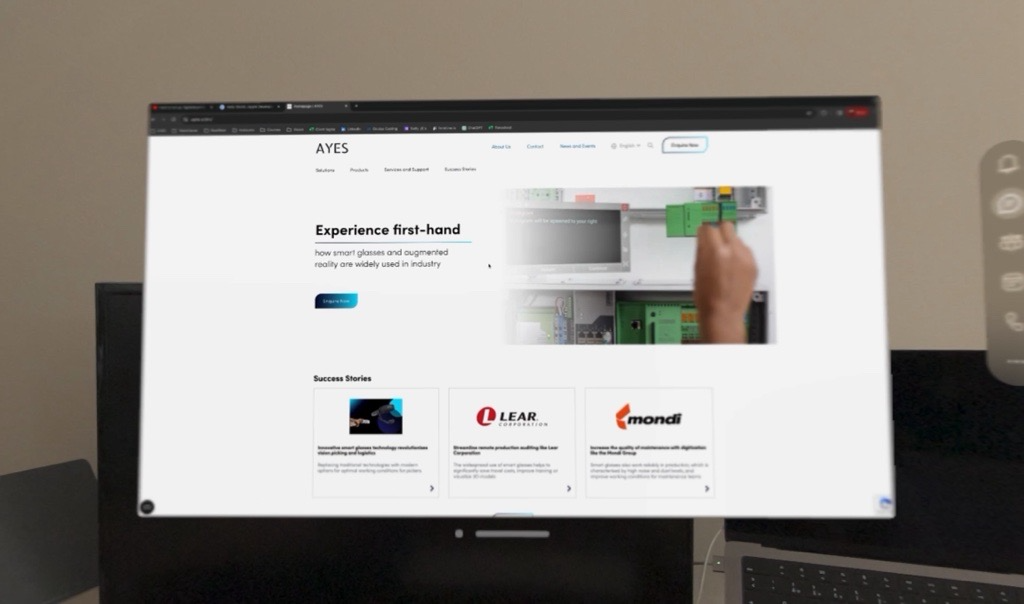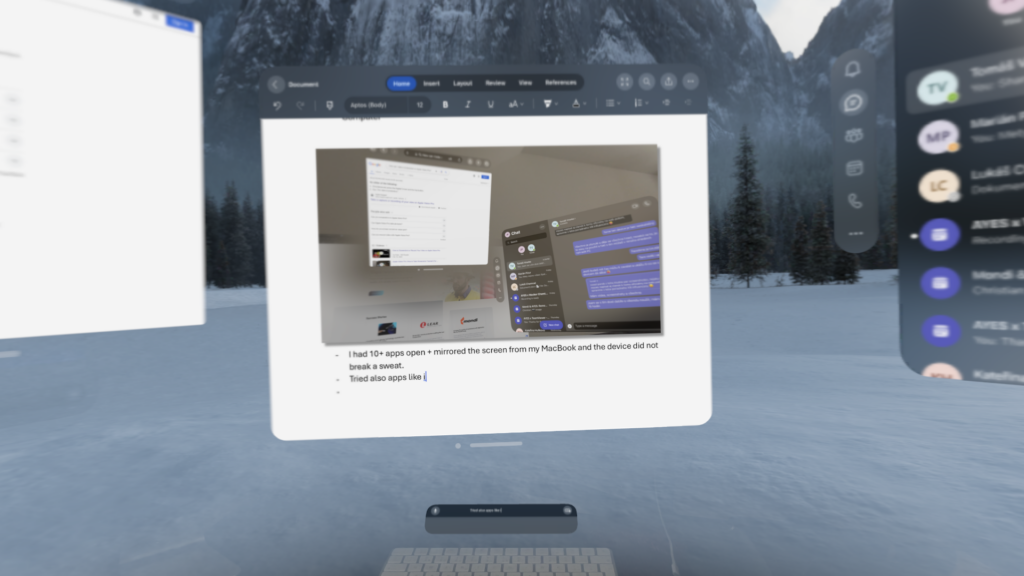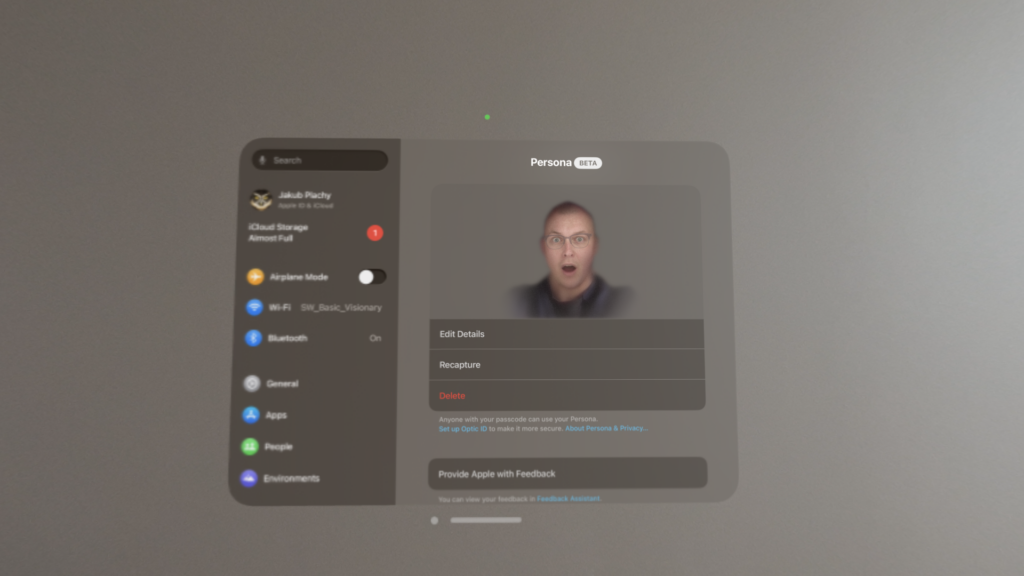Our colleague Jakub Plachý has written for you his experience with using Apple Vision Pro smart glasses.
Apple Vision Pro – a new industry standard
Dear reader, thank you for taking the time to read this short article. Please note that these are my personal opinions, not objective statements of fact. The article goes through my personal 72-hour experience with the device, where I tried to go through different aspects of it and tested different types of scenarios, such as productivity, VisionOS generally, industrial apps and also some quirks I was not particularly fond of (to add some balance to the article). I hope you find the article insightful!
1. Apple’s ecosystem
The interconnectedness is a widely known phenomenon among Apple users, but the simplicity and user-friendliness were something I have never experienced before on any other headset. I went through the onboarding process in minutes and everything was set up: my Apple wallet, messages, photos, contacts, iCloud, emails…. everything. This is very crucial in terms of mass adoption in the future. Currently available headsets are typically more “closed” and not as interconnected, and this is where Apple has an enormous advantage over its competitors. I’m not saying that similar things can’t be achieved on other XR devices, but Apple’s polish and attention to details just hits different.
The above made me realize that AVP is probably mostly intended as a personal device, provided that one’s aim is to “make the most out of it”. And that I most definitely did. I immediately mirrored my Mac’s screen into my real environment, FaceTimed with my friends and paired my Magic Keyboard to the headset to do some work. The digital bar above the keyboard is a brilliant touch and it works so well!
While the above is exciting and feels strangely new, I wonder how industrial companies will end up leveraging the device’s potential. I can’t imagine every team member having their own Macbook Pro and Vision Pro due to the setup being somewhat pricy. I could, however, imagine there being multiple AVPs paired with Magic Keyboards to be shared, and sharing of XR devices is typical in corporate environments. And speaking of sharing, this is probably the biggest shortcoming of the device. I particularly do not like how Apple handled this, it seems overly complicated and the device is very clearly dependent on the individual’s eye callibration, but this plays directly into my argument about AVP being a personal device.
Although, to be fair, the device already supports MDM integration, so I’m sure it will be, and probably already is, rendered very usable even in professional environments, as many Apple products already are, but AVP is definitely unique in its potential to expand the XR use cases to new, greater heights, especially in terms of 3D data visualization, training, collaboration, productivity and probably many more. Sky is the limit!
2. General productivity
I was initially sceptical towards Apple’s marketing, especially when it came to their productivity claims. I saw it as a gimmick and a desperate attempt by Apple to come up with a use case, but I might have been riding a wrong conceptual horse on this one!
Once I paired my Magic Keyboard to AVP, I understood what Apple meant by “Spatial Computing”. I placed the mirrored screen from my Macbook Pro in front of me and a bunch of native AVP apps all around it and it was a shockingly smooth experience. In fact, the draft for this very article was all conjured up on the AVP, and writing, editing, switching between apps and adding screenshots did not feel any slower compared to working on a computer, and I think this is one of the key aspects that sets AVP apart from any other XR device currently on the market. It also eliminates that annoying feeling of never having enough displays and having to cram everything into segments or tabs on a 2-3 screen setup. Paired with the ability to partially immerse yourself in high-quality soothing VR environment makes this device truly stand out.
Next thing that struck me was how many apps I could actually have running simultaneously without the device breaking a sweat. Things like FaceTime, MS Word, Safari, ChatGPT and the mirrored screen from my Macbook, all running in parallel, yet I could not observe any performance drops, which was mind-blowing. Switching between apps was also effortless and blazing fast, mostly thanks to the eye tracking control scheme, which I think Apple nailed 100%, though I did hear that this option does not work for everybody.
One key aspect enhancing and making productivity a lot easier and faster is AirDrop. Data sharing between Apple devices is simple, fast and pretty much anything can be shared, 3D models included.
Thanks to these, I can fully imagine the device being used in ways other XR headsets are simply not, and it is thanks to AVP’s ability to fully perform certain aspects of traditional computing in an effortless and connected manner – and in XR, no less. I think the success or failure of this will all come down to app support and how polished the apps will be, the rest is already there!
3. Apps for manufacturing industry
I later fired up AppStore to try out apps specific to what I do for work: visualizing industrial 3D objects. Unfortunately, there was not a whole lot there, but I did find one app that stood out from the rest: JigSpace.
This app was closest to what our company offers for 3D use cases, and it did not disappoint, though I only tried the free version for now. JigSpace’s level of polish on the AVP is noteworthy, so shout to you guys, what a stunning achievement!
While I can’t imagine the app being able to visualize extremely complex 3D objects with millions of triangles, hundreds of collections and thousands of subassemblies using only the device’s computational power, the general idea is there, and boy does it look good. And the model complexity could be later solved by local or remote rendering anyway.
I was happy to see that the device is fully capable of facilitating smooth interaction with 3D objects, even taking them apart piece by piece. And the visuals were absolutely amazing, unlike anything I’ve ever seen on a standalone headset. There’s even reflections. I know that looks are not the most important aspect, but it makes a huge difference in terms of immersion and believeability.
By the way, I AirDropped myself our own 3D models and the default model viewer was able to handle 5 million polygon model pretty well, which would be great for basic factory layout planning or presenting a prototype to a customer.
I wonder what industry leader companies like Hololight or TeamViewer will come up with in the hopefully near future in terms of their own apps, which we at AYES use for various purposes.
4. Collaboration and Personas
Undoubtedly, and especially for industrial applications, being able to work in a shared workspace, be it locally or remotely, is essential to achieve the most in the shortest possible timespan effectively. Thankfully, it seems that Apple kept this in their mind when designing the headset, since it seems that Shareplay will be a big part of the experience, though so far it seems very limited.
However, I see a huge potential in this in the future, as the uncanny valley type reconstruction of my face at the moment looked a bit off-putting, it will keep getting better and better and there are already native AVP apps where this can be utilised, like AppleTV and FaceTime, and FaceTime already brings some interesting features, like seeing windowless spatial avatars with correct spatial audio and the presence looks very real.
Knowing Apple, “multiplayer” will most likely be easy to achieve for the end users, which at the moment is generally somewhat tricky to set up in mixed reality on other headsets, where origin has to be aligned manually using spatial anchors like QR codes and generally apps seems to have different approach to this.
5. VisionOS
I hear a lot about Vision Pro needing a killer app, but from what I tested so far, it seems that the operating system itself is kind of a killer app overall. The sleek design, the familiarity, the smoothness and user-friendliness paired with how interconnected all of it is, is a paradigm shift in the realm of extended reality operating systems.
All of it looks familiar and pretty, windows cast shadows on surfaces, and even 3rd party apps, at least so far, look like they are part of VisionOS, which is something I personally miss in other headsets, where many apps look nothing like the rest of the OS. Also, and this is a big one, iPad apps are likewise supported, and it seems that most of them work out of the box, and from what I hear, it is easy for developers to make their iPad apps compatible with VisionOS.
6. Quirks
While I was blown away by the what the device can do and by the level of polish being what it is, there were some things that were not perfect.
First of all, sometimes the eye tracking did not work as I’d expect, especially for far away objects and small buttons, and particularly in certain web apps like YouTube, I found it almost impossible to highlight the Full Screen mode button, and also for peripheral objects I had to turn my head around quite a bit. Resizing windows sometimes posed a significant challenge and I could not find a consistent way of finding that sweet spot. Additionally, navigating the user interface occasionally presented challenges, such as when trying to resize windows or access the control center.
Limitations in third-party applications like MS Teams and Zoom, that couldn’t access the device’s front cameras, were disappointing. I also found the lack of useful apps to be a hinderance, but this is likely to change in the future.
Passthrough is likewise slightly worse than I initially expected.
7. Hefty price tag
This one is possibly the reason why most people won’t opt it for the device, though I’d like to offer another perspective on this. Other professional mixed reality headsets cost the same (between 3.500 – 4000 EUR), for instance Microsoft HoloLens 2, or Magic Leap 2. While both of the aforementioned devices are stunning achievements (especially HoloLens 2) and are both very usable for industrial applications, I believe they do not come even close to what Apple came up with, especially in terms of quality and the ecosystem. The transition from limited devices made for specific purposes to a universal standalone spatial computer is something that is very much needed, and it is something that no other headset currently has on the market. Vision Pro has the potential to make the mixed reality experience in the industrial sector more immersive and easier to use than ever before, and that is something that should not be taken lightly.
Once relevant apps are developed or supported on the AVP, I think we are looking at a device that no company will have an issue purchasing for the use cases I mentioned earlier. As for the general public, I think they’ll wait for a less pricy version.
8. Conclusion
It is very clear that Apple put a ton of thought and effort into the Vision Pro and I’d argue it has enormous potential to make XR more mainstream, but especially, to set a whole new industry standard, which is very much needed.
Thanks to the fact that Vision Pro is such a versatile and usable device, I do believe it will eventually succeed, if developers come up with “killer apps”. Despite the widespread scepticism I keep finding online, I’d still argue that what Apple managed to pull off is nothing short of spectacular, and I’m keeping my fingers crossed for them. And let’s not forget that this is a first generation product, so this will keep getting better and even more polished in the future.
Overall, the visual quality, the interconnectedness, the raw power and the Apple ecosystem make this device truly stand out among its competitors and offer an unparalleled experience.
Oh, and I’m buying the device for myself as soon as it officially launches in Europe, so looking forward!
Rental of Apple Vision Pro smart glasses
Explore innovative possibilities without making an immediate investment in your own Apple Vision Pro smart glasses.







